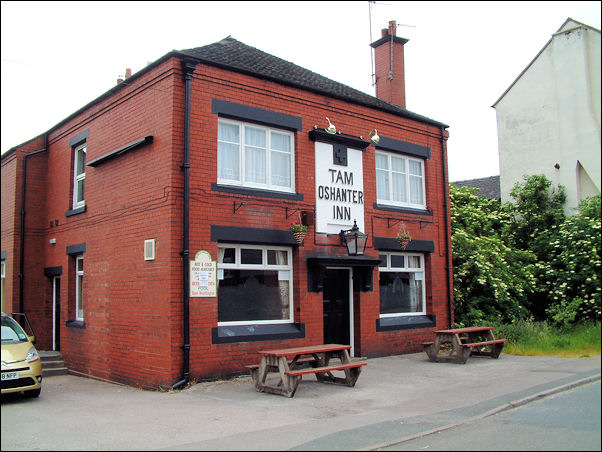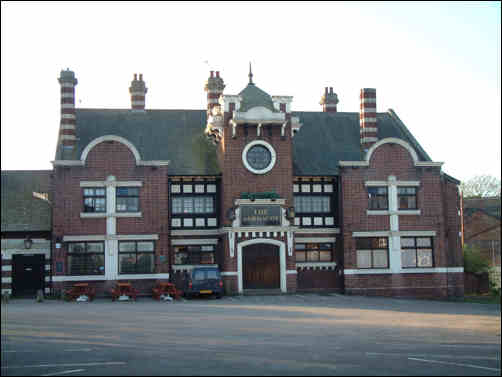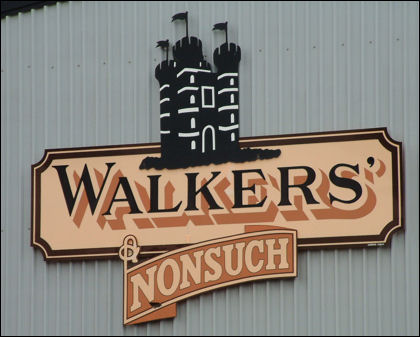|
Normacot Road, Longton
road to nowhere links past to
future
  
click the
"contents" button to get back to the main index & map
previous: Etruria Road (Fowlea Bank)
next: Grove Road, Heron Cross
|
Historian Fred Hughes
writes....
The
intersection of Normacot Road by the A50 has created two different
communities where one a close-knit one was formerly shared.
When
Chris and Laura Probert moved home they only had to go to the other end of
the street. Trouble is, the street they live in has been divided by a
two-carriage motorway complete with a double-island intersection. If this
sounds difficult to understand, it’s even harder to negotiate.
“It’s
like two different towns,” says Chris, who recently moved from the
Normacot Hotel to keep the Tam o’ Shanter. “Both pubs are in Normacot Road
but the line has completely disappeared. The A50 has completely severed
the community across the middle and I can assure you the two sides have
very little in common these days.”

The Tam O' Shanter Inn -
on the Normacot side of Normacot Road

The Normacot public
house - on the Normacot side of Normacot Road
Tam ‘o
Shanter regular Eric Rushton aged 70, agrees.
“I was
born and brought up around here,” he says. “I went to Queensbury School
in Normacot Road. Best school in the Potteries that was. They could fill
a Stoke City first team with footballers. The two Boswells, Corbishley,
Vic Wooley all went to Queensbury as did Alan Bloor and Denis Smith. The
place isn’t the same since they opened the A50. The side with the Tam o’
Shanter on is dead.”
|
Indeed
it is very quiet. Hardly any traffic moves along Normacot Road or the two
parallel roads, Uttoxeter Road and Lower Spring Road. They all terminate
as dead-ends at the A50 hectic Intersection.
“Normacot Road was once an important domestic and industrial thoroughfare
in Longton,” explains historian Steve Birks. “Lined with many pot-works
and terraced houses, people worked and lived here in their thousands. But
many of these houses and factories were demolished between the 1930’s and
the 1970’s through slum clearances. And of course the opening of the A50
road in 1997 meant the end of Normacot Road as a main road. I suppose
these days you can call it a road to nowhere.” |
I
recall my old friend Les Lockett of Edwardian China in Normacot Road
reminiscing about his youth here. Les is 87 and was born a few yards from
his factory gates. He tells me:
“Across
the road was a coal yard where women used to weigh coal by the barrowful.
Before I went to school and in my lunch break I delivered coal in those
barrows. Three tons each day I weighed out and carried from that yard.
Normacot Road was a dark and dirty place then.”
Les
remembers looking out and seeing nothing but smoke polluting the Longton
air 365 days a year. He’s still able to name a bewildering number of
potteries that once stood between Edwardian China and St James Church, a
distance of just 200 yards.
“The
population was greater and people lived where they worked. When I was a
boy there were 72 pubs from Normacot Road to Longton town centre. And they
were all well-used to break the monotony of life,” he recalls. “The coal
yard disappeared many years ago and just a tiny row of terraced houses
remain out of hundreds.”
Opposite the Tam o’ Shanter is the factory of Walkers’ (Nonsuch) Toffee in
Calverley Street where I meet marketing director Emma Walker.
“We’ve
always been a family business,” declares Emma with a childlike
toffee-logo smile. “That’s definitely the secret of our success.”
Stoke
on Trent’s world-famous confectioners began life as a tiny sweet shop at
the back of a pottery.
“Edward
Joseph Walker was my great, grandfather who began making toffee for
local customers in the 1890's with his sister Florence. It proved to be
an inspired secondary business for the toffee was so popular that in
1915 Edward and his son Edward Victor Walker, founded Walkers’ Nonsuch
as an independent family company. Together they made toffee in single
batches based upon Edward Joseph's original recipes. It became a limited
company in 1922.”

Walkers’ Nonsuch
Like most people I wonder about the quaint banner-name Nonsuch.
“The
Nonsuch word takes its origin from Henry VIII’s fabulous palace near
Epsom in Surrey. It was the palace of palaces because of its splendour.
And people said there was none such like its majesty. Edward Joseph and
his son made the same comparison with the trade name,” explains Emma.
“It was Walkers’ way of saying there was no toffee better than theirs.”
After the war Walkers’ moved to its present extended site.
“The
new premises had been a sweet factory since 1894 belonging to the
Horleston brothers,” Emma continues. “When Edward Victor died in 1962,
my father Ian his brother Edward, became managing directors investing in
modern equipment to increase the output. The important thing was to keep
to the family standards. And this has been the key to our success.”
Walkers’ Nonsuch continues its family traditions and original methods.
Ian, in his seventies, actively continues as head of the business and his
daughters, Kate and Emma are involved in sales and marketing with nephew
Edward Nicholas Walker responsible for production.
The A50 may have turned this old Longton
thoroughfare into a cul-de-sac. But if you want to see the Potteries how
it used to be you can still savour it here in Normacot Road.
 see
more on Normacot Road
see
more on Normacot Road |
![]()
![]()
![]()